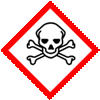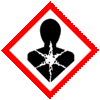Clenbuterol hydrochloride or Clenbuterol HCl Manufacturers, with SDS GHS MSDS Sheet |
Supplier, Manufacturer, Exporter of Clenbuterol hydrochloride or Clenbuterol HCl, Muby Chemicals of Mubychem Group, established in 1976, is the original manufacturers of Specialty Chemicals, Pharmaceutical Excipient, Fragrance Food & Flavor chemicals, Reagent Grade Chemicals, Shale Gas Fracturing Chemicals in India. Mubychem Group has several manufacturing facilities spread across Western India and world wide contacts and toll manufacturers. We are exporting globally to countries like USA, Canada, Europe, UAE, South Africa, Tanzania, Kenya, Egypt, Nigeria, Cameroon, Uganda, Turkey, Mexico, Brazil, Chile, Argentina, Dubai, Korea, Vietnam, Thailand, Malaysia, Indonesia, Australia, China, Germany, France, Italy Portugal, Bangladesh, etc. The products are offered as per required specifications and in correct shape and size in mm or meshs or microns as specified by the buyer. The participating units have one or more accreditations like FDA - cGMP and GLP approval, ISO-9001 Certified, "REACH" Registered, ISO-14001, ISO/IEC 17025, ISO-22000, FSSC 22000, ISO 45001, Kosher Certified, Halal Certified, HACCP, FSSAI. We offer Commercial Pure & IP BP EP Ph Eur USP NF JP FCC Food Grade Analytical Reagent Grades of Chemicals |
| Bookmark this Web Site -- or -- Email This Page Info to a Colleague or Yourself |
Search our website here:







Clenbuterol hydrochloride or Clenbuterol HCl: CAS Number: 21898-19-1, EINECS EC Number: 244-643-7, Molecular Formula: C12H19Cl3N2O or C12H18Cl2N2O-HCl, Molecular Weight: 313.65, HS Code ---**
How big is your requirement or how small
We serve it all.
Specifications, Safety Data Sheet, Manufacturing process details, Wholesale retail buy sell prices, Uses etc available on line in these pages for Clenbuterol hydrochloride or Clenbuterol HCl.
For SDS MSDS Sheet Click
SDS MSDS Sheet of Clenbuterol hydrochloride or Clenbuterol HCl Manufacturers
Clenbuterol hydrochloride
Clenbuterol HCl Pure Suppliers

Properties and Specifications of Clenbuterol hydrochloride or Clenbuterol HCl:
Appearance: White to off-white crystalline powder.
Assay: 98% minimum.
Melting point: 174C to 175.5C.
Boiling point: 405C.
Solubility: Soluble in water (50 mg/ml), ethanol, and methanol.
Storage: Refrigerator; Shipping at room temperature.
Meets specifications of BP EP USP.
We also manufacture and supply as under:
Creatine HCl or Creatine Hydrochloride
Manufacturers:
MUBY CHEMICALS
Ambernath Mumbai, Ankleshwar Gujarat, India
TEL: (OFFICE) +912223770100, +912223726950
Current Date Time in India GMT+5:30
e-mail: info@mubychem.com
USA, Canada, Mexico and other American neighbouring buyers may
e-mail: us@mubychem.com
Call toll-free 1-877-682-9243 (1-877-MUBYCHEM)

Copyright and Usual Disclaimer is Applicable.
Last 22 November, 2025




Exporters to USA Canada UAE Europe South Africa Tanzania Kenya Uganda Egypt Nigeria Turkey Mexico Brazil Argentina Chile Dubai etc.
Global or International Suppliers, Exporters, Importers, Manufacturers
I shall pass through this world, but once. If therefore, there is any good that I can do, or if there is any favor that I can show to a fellow human being, let me do it now. Let me not defer or neglect it. For I shall not tread this way again
Clenbuterol hydrochloride or Clenbuterol HCl SDS, Safety Data Sheet
MSDS Sheet, Material Safety Data Sheet 10-Oct-20
1. Product Identification
Product Name & Other Names: Clenbuterol hydrochloride or Clenbuterol HCl.
CAS Number: 21898-19-1
EINECS EC Number: 244-643-7
Molecular Formula: C12H19Cl3N2O or C12H18Cl2N2O-HCl
Molecular Weight: 313.65
Intended Use: Industrial Manufacturing.
Relevant uses and uses advised against (if any): Industrial Manufacturing.
Suppliers: As per letterhead.
2. Hazards Identification
GHS, Globally Harmonized System Classification in accordance with 29 CFR 1910
Classification according to Regulation (EC) No 1272/2008
Acute toxicity, Oral: Category 3, H301
Reproductive toxicity Category 2, H361
Labeling according GHS USA & Regulation (EC) No 1272/2008
GHS Label Elements  Toxic | GHS Label Elements  Health Hazard |
Signal Words: Danger
Hazard Statements:
H301: Toxic if swallowed.
H361: Suspected of damaging fertility or the unborn child.
Precautionary Statements:
P202: Do not handle until all safety precautions have been read and understood.
P260: Do not breathe dust/fume/gas/mist/vapors/spray.
P262: Do not get in eyes, on skin, or on clothing.
P264: Wash contaminated parts thoroughly after handling.
P270: Do not eat, drink or smoke when using this product.
P280: Wear protective gloves/protective clothing/eye protection/face protection.
P301+P310: IF SWALLOWED: Immediately call a POSION CENTER or doctor/physician.
P314: Get medical advice/attention if you feel unwell.
P302+352: IF ON SKIN: Wash with plenty of soap and water.
P305+351+338: IF IN EYES: Rinse cautiously with water for several minutes. Remove contact lenses if present and easy to do – continue rinsing.
Classification according to EU Directives 67/548/EEC or 1999/45/EC:
Hazard Symbols:
T Toxic
Xn Harmful
Risk Phrases:
R25 Toxic if swallowed.
R60 May impair fertility
R61 May cause harm to the unborn child.
3. Composition/Information on Ingredients
Product Name & Other Names: Clenbuterol hydrochloride or Clenbuterol HCl.
CAS Number: 21898-19-1
EINECS EC Number: 244-643-7
4. First Aid Measures
Inhalation: Remove affected person to fresh air; if normal breathing has not returned within a few minutes after exposure, get medical attention.
Skin: Remove contaminated clothing; wash affected area with soap and water; launder contaminated clothing before reuse. Seek medical attention.
Eyes: Immediately, flush eyes for 15 minutes in clear running water while holding eyelids open; seek medical attention immediately.
Ingestion: Drink two glasses of water followed by milk, milk of magnesia or other non-alcoholic liquids; Do not induce vomiting; seek medical attention immediately.
Physician may treat symptomatically.
5. Fire Fighting Measures
Flammable Limits: No unusual fire or explosion hazards noted.
General Hazards: Contact with eyes causes immediate severe irritation of the eye and eyelids. Product will support combustion.
Extinguishing Media: Carbon dioxide, water fog, dry chemical, chemical foam.
Organics solids, may be ignitable. Keep containers cool by spraying with water. Use extinguishing media appropriate for surrounding fire.
Fire & Explosion Hazard: May evolve toxic fumes, oxides of carbon (COx), oxides of nitrogen (NOx) under fire conditions.
In case of fire, wear a full face positive-pressure self-contained breathing apparatus and protective suit. Self - contained respiratory equipment; cool containers to prevent pressure buildup and possible explosion when exposed to extreme heat. Caution - material will support combustion!
Hazardous Combustion Products: Products of combustion include smoke, toxic fumes, oxides of carbon to include carbon monoxide, nitrogen oxides, hydrogen chloride.
Specific Methods: Cool containers exposed to flames with water until well after the fire is out.
Special Information: In the event of a fire, wear full protective clothing and NIOSH-approved self-contained breathing apparatus with full face piece operated in the pressure demand or other positive pressure mode. At high temperatures under fire conditions, it may produce toxic or irritating fumes.
6. Accidental Release Measures
Personal precautions, protective equipment and emergency procedures: It may support combustion. Do not touch damaged containers or spilled material unless wearing appropriate protective clothing. Avoid breathing dust/fumes/gas/mist/vapors/spray. Use individual protective equipment (waterproof boots, suitable protective clothing, safety glasses, etc.). Restrict unprotected personnel from the area. Prevent any contact with hot surfaces. Do not approach facing the wind. Do not touch the spilled material.
Environmental precautions: Do not let the product enter drains, soil or water sources.
Methods and materials used for containment Cleanup procedures and Storage: Contain spilled material. Cover with an inert, non-combustible absorbent material, (e.g. sand, earth, diatomaceous earth, vermiculite). Vacuum or sweep-up and remove to an approved disposal container.
7. Handling and Storage
Precautions for safe handling: Apply according to good manufacturing and industrial hygiene practices. Ensure proper ventilation. Wash thoroughly after handling. Do not drink, eat or smoke while handling. Avoid contact with skin, eyes and clothing. Minimize dust generation. Avoid breathing dust/fumes/gas/mist/vapors/spray. Provide appropriate exhaust ventilation at places where dust is formed. Avoid contact with eyes, skin, and clothing. Keep container tightly closed. Avoid ingestion and inhalation. Use individual protective equipment (waterproof boots, suitable protective clothing, safety glasses, etc.). Prevent any contact with hot surfaces.
Conditions for safe storage, including any incompatibilities: Store in cool, dry and ventilated area away from heat sources and protected from sunlight in tightly closed original container. Keep air contact to a minimum. Do not leave the material container open. Store protected from heat, sparks and ignition sources and incompatible materials. Avoid contact with skin and eyes. Avoid inhalation of dust/mist/vapor. Do not store with incompatible materials like strong oxidizing agent. Keep this and other chemicals out of reach of children. Storage: Refrigerator; shipping at room temperature.
8. Exposure Controls/Personal Protection
Engineering Controls: The use of local exhaust ventilation is recommended to control emissions near the source. Provide mechanical ventilation of confined spaces. Use corrosion-resistant, explosion-proof ventilation equipment.
Exposure Limits: Not established.
Personal Protection: Respiratory Protection (Specify Type): None required while threshold limits are kept below maximum allowable concentrations; if TWA exceeds standard workplace limits, NIOSH approved respirator must be worn.
Hand Protection: Neoprene, butyl or nitrile rubber gloves with cuffs.
Eye Protection: Chemical safety goggles.
Other Protective Clothing Or Equipment: Apron, or other equipment should be worn to prevent skin contact, safety eyewash station nearby. Practice safe workplace habits. Minimize body contact with this, as well as all chemicals in general.
9. Physical and Chemical Properties
Appearance: White to off-white crystalline powder.
Odor: Not available.
Odor threshold: Not available.
pH: Not available.
Relative density: Not available.
Melting/Freezing Point: 174C to 175.5C.
Initial boiling point and boiling range: 405C.
Flash point: Not available.
Auto-ignition temperature: Not available.
Decomposition temperature: Not available.
Upper/lower flammability or explosive limits: Not available.
Vapor pressure: Not available.
Vapor density: Not available.
Evaporation rate: Not available.
Flammability (solid, gas): Not available.
Partition coefficient: n-octanol/water: Not available.
Solubility: Soluble in water (50 mg/ml), ethanol, and methanol.
Viscosity: Not available.
Molecular Formula: C12H19Cl3N2O or C12H18Cl2N2O-HCl
Molecular Weight: 313.65.
10. Stability and Reactivity
Stability: Stable at normal temperatures and operating conditions.
Conditions to Avoid: Avoid excessively high temperatures and contact with alkalis or strong oxidizing agents.
Incompatibilities: Strong Oxidizing Agent.
Decomposition: Decomposition yields toxic fumes, oxides of carbon (COx), oxides of nitrogen (NOx), hydrogen chloride.
Polymerization: Polymerization will not occur.
11. Toxicological Information
Toxic if swallowed.
Toxicity Data:
LD50 Oral - Rat - 159 mg/kg
Reproduction: Suspected human reproductive toxicant.
Mutagenicity: Mutagen, and reproductive effector.
Carcinogenicity: Not listed as a human carcinogen by OSHA, IARC, ACGIH & NTP.
12. Ecological Information
Toxicity to fish: Not available.
Results of PBT and vPvB assessment: No data available.
Persistence and degradability: No data available.
Bioaccumulative potential: No data available.
Mobility: No data available
13. Disposal Considerations
Dispose of in accordance with Local, State, and Federal Regulations. Consult local, state, or Federal Environmental Protection Agency before disposing of any chemicals.
14. Transport Information
DOT USA & ADR/RID Europe
Proper Shipping Name: TOXIC SOLID, ORGANIC, N.O.S. (Clenbuterol hydrochloride)
UN#: 2811; Class: 6.1; Packing Group: Packing Group III
IATA & IMDG
Proper Shipping Name: TOXIC SOLID, ORGANIC, N.O.S. (Clenbuterol hydrochloride)
UN#: 2811; Class: 6.1; Packing Group: Packing Group III.
15. Regulatory Information
No significant information is available.
Section 16 - Additional Information
European Labeling in Accordance with EC Directives:
H301: Toxic if swallowed.
H361: Suspected of damaging fertility or the unborn child.
Classification according to EU Directives 67/548/EEC or 1999/45/EC:
Hazard Symbols:
T Toxic
Xn Harmful
Risk Phrases:
R25 Toxic if swallowed.
R60 May impair fertility
R61 May cause harm to the unborn child.
Disclaimer:
**************************
Our company provides this MSDS sheet in good faith but makes no representation as to its comprehensiveness or accuracy. This SDS sheet is intended only as a guide to the appropriate precautionary handling of the material by a properly trained person using this product. The above information has been compiled from various sources and has the possibility of discrepancy and being out-dated information. Individuals receiving the information must exercise their independent judgment and do further search in determining its appropriateness for a particular purpose. In no case shall our company be liable to loss or damages by the product user.
**************************
















